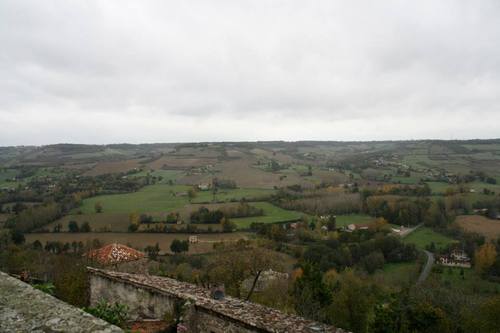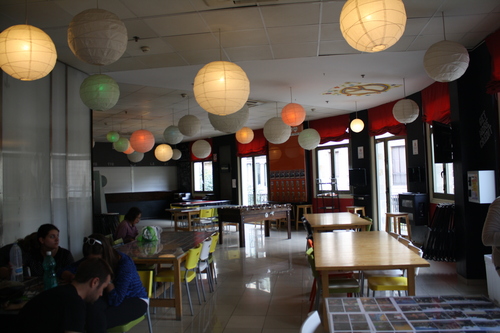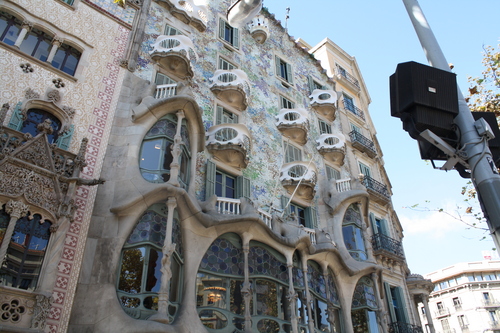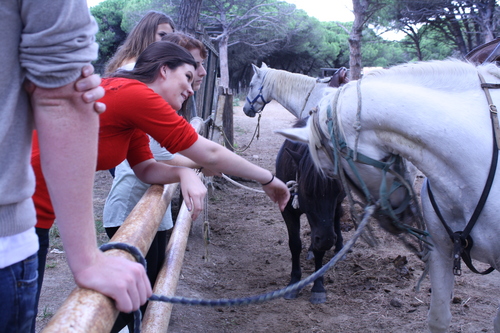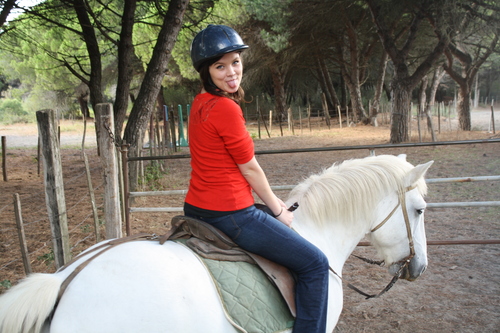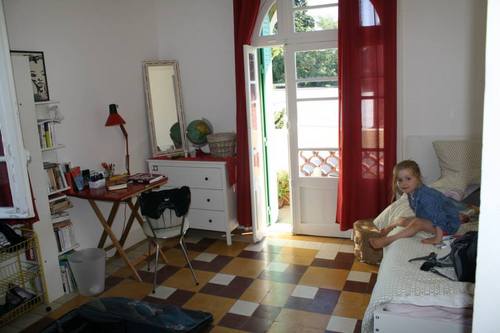Adfrenchures: Chapitre 2
Jeu d’enfant / Child’s Play
 Tea lights flickered in their lanterns, hanging from a fig tree in the backyard. A handful of rowdy toddlers switched off playing with binoculars, a plastic truck, and three heavy p�tangue balls, quite graciously taking turns with their toys. As I stood guard between the kids and the blazing logs of the barbeque fire, Liam, 4 years old, waddled up to me and gave me a stuffed tiger. It was bigger than him, so that when he carried it, the back legs dragged through the grass.
Tea lights flickered in their lanterns, hanging from a fig tree in the backyard. A handful of rowdy toddlers switched off playing with binoculars, a plastic truck, and three heavy p�tangue balls, quite graciously taking turns with their toys. As I stood guard between the kids and the blazing logs of the barbeque fire, Liam, 4 years old, waddled up to me and gave me a stuffed tiger. It was bigger than him, so that when he carried it, the back legs dragged through the grass.
“This is yours now,” he told me in baby French. I accepted the tiger graciously.
“Thanks, I’ll hang on to him for you,” I said, but then he motioned for me to crouch down.
“The tiger’s sick,” he informed me gravely, “His tail is hurt.”
Understandably, I went into emergency mode.
“We need a doctor! Is anyone a doctor? Doctor Mila! Calling Doctor Mila!” I shouted urgently. My host sister ran over, as this was a game we had played before with her teddy bear. (That poor teddy bear keeps getting sore throats.) She more or less tried to stick the binoculars up the stuffed tiger’s butt, and then declared him miraculously cured. She and Liam wandered off to go sit on the swings.
I’ve been spending a lot of time with my host family for this past week. With the start of class at Paul Val�ry and all the new things to do here, it’s left me barely enough energy to do my homework, let alone write this blog entry that’s been stewing in my brain for weeks.
I hope to write more consistently as I get settled in to a schedule and manage to actually attend my courses. I promise not all of my blog entries will be this long!
Last Friday, we went to a friend’s BBQ, where everyone was either under 10 or over 30. Many of the parents were like Anysia and Mathieu with children around 3 years old.
No one was able to truly relax and talk until 22h (10pm), when the kids were put to bed upstairs, the BBQ was finished, and about seven empty bottles of wine* littered the table. Liam gave me the stuffed tiger to hang onto again, so it sat underneath my chair while I ate. It was easier to talk to the kids, as when they didn’t understand me, they looked at me like I was a crazy person. Sometimes adults are too polite.
 Over a huge stack of the most delicious barbeque I’ve ever eaten, I mostly listened as the adults talked about their children: the start of the new school year, Mila’s newfound fear of witches and monsters that made putting her to bed difficult, how to tackle the question when a toddler asks you “What happens after we die?” and isn’t satisfied with the response “No one really knows.” In fact, other than the French food and geographic location, this BBQ could’ve been a group of parents in any country.
Over a huge stack of the most delicious barbeque I’ve ever eaten, I mostly listened as the adults talked about their children: the start of the new school year, Mila’s newfound fear of witches and monsters that made putting her to bed difficult, how to tackle the question when a toddler asks you “What happens after we die?” and isn’t satisfied with the response “No one really knows.” In fact, other than the French food and geographic location, this BBQ could’ve been a group of parents in any country.
Eventually, as is apt to happen, the conversation turned to differences between the United States and France. This is generally when I have to take off my listening cap and try to form coherent sentences in another language, so the pressure is on. We talked about the go-to comparison that everything in France is smaller (or, depending on your perspective, everything in the US is bigger). We talked about tipping waiters, and one dad informed me that he found the servers in the US to be one thousand times nicer than those in France.
“You walk in and they say ‘Hi, how are you? Here’s what we have on our daily menu,’ and they laugh and joke with you. Servers in America want to be your friend,” he explained, “It completely shocked us.”
“That explains why when I smile at servers here and ask for coffee, I’m so confused when they don’t talk to me,” I realized aloud. The icy cold blood of French servers was confirmed by the whole table.
But honestly, when it comes to cultural comparison, there isn’t much difference between America and France when it comes to the everyday / quotidien.
France isn’t like stepping into a different world. It’s like stepping into the same world, only you have to pull the flush button up instead of down and use bread to clear your plate instead of leaving it and say “God thanks (Dieu merci)” instead of “Thank God.”
France is like walking into your room only to find all of your things have been slightly rearranged. Your furniture isn’t in exactly the right place and some small things are missing. Maybe a window seems to have popped up on a different wall. But it’s still fairly recognizable as your room. In fact, you find many of the changes useful and don’t miss a lot of the things that aren’t there.
Ryan, who’s Geoblogging from South Korea, asked me to talk about French people’s habits and how they compare to stereotypes. This sensation of simply being in a shifted room has made it difficult for me to narrow down what’s simply human from what’s more ‘definitively French,’ whatever that means.
For instance, Mila cries every morning because she doesn’t want to go to school. We eat dinner around 6:30 or 7:00 and finish around 8:00 or 8:30 every night, which is a little later than in the US. There is no dryer in the house; they hang their laundry out to dry. On Saturday mornings, we go to the local farmer’s market under Les Arceaux and buy groceries. Then we drink “un coup” with friends at the caf� La Cigale, because the market is almost more social experience than shopping trip.

 It’s been three weeks, and I can count on only one hand the number of times I’ve had a peaceful tram ride. I am constantly being hit on by French men, something that I seem to be experiencing with greater frequency and severity than others on the program. The French have different body language when out in public– they are cold, uninterested, and bustling. It’s difficult for me to reign in my eyes when I want to look at everything, so the program and I think the problem might be that I’m still adapting to French body language. Loud headphones and a book on the tram have not stopped the requests for my phone number or, that one time, from a random guy trying to romantically tuck my hair behind my ear. Uh, pardon, monsieur. I don’t know you and I just told you, “Sorry, leave me alone.”
It’s been three weeks, and I can count on only one hand the number of times I’ve had a peaceful tram ride. I am constantly being hit on by French men, something that I seem to be experiencing with greater frequency and severity than others on the program. The French have different body language when out in public– they are cold, uninterested, and bustling. It’s difficult for me to reign in my eyes when I want to look at everything, so the program and I think the problem might be that I’m still adapting to French body language. Loud headphones and a book on the tram have not stopped the requests for my phone number or, that one time, from a random guy trying to romantically tuck my hair behind my ear. Uh, pardon, monsieur. I don’t know you and I just told you, “Sorry, leave me alone.”
Small cultural difference: pepper spray is ostensibly illegal in France.
One difference between the France and the US is the university system. In keeping with my room metaphor, the French university system is as if someone came into your room, exchanged your laptop with one from the early 90’s, and then proceeded to throw all your stuff around as if a tornado had passed through the house.
The course registration process is a nightmare, and that’s where the University of Minnesota study abroad team are absolute life savers. They do most of the legwork and we just leisurely select our schedule out of a compiled list of classes. Erasmus students and other programs don’t have this luxury; they need to show up, in person, at the secretary of every department they need to schedule a class in, wait in line, and physically write their name on a piece of paper. Even then, there may or may not be secondary or tertiary steps for them to confirm their inscription.
I have showed up for three classes this week where I was not able to successfully learn. For the first, the professor did not show up. For the second, the class was permanently moved to a different day and time, without informing half the class. For the third, my contemporary dance class, the professor was two hours late and showed up just in time to say, “Hello, see you next week!”
As for smoking, the critically-thinking PLA member in me just can’t figure it out. The stereotype is that everyone smokes in France. A great number do. If you go out on the streets, you will see many more smokers than in the US (probably, I am literally eyeballing this number).
A ton of people here handroll their own cigarettes with papers, filters, and loose tobacco. My artist host dad handrolls his blond tobacco cigarettes after breakfast, lunch, and dinner, and while he’s working in his studio; however, I have seen high school students outside of the Lyc�e Joffre rolling themselves a Marlboro. So the frequency of handrolled cigarettes is another one of those “slightly adjusted furniture” moments.
But is it really that there are more smokers? Or is it that smoking is more socially acceptable in France, so they feel more comfortable smoking out in public, and thus we see them more, providing the illusion of more smokers?
I also can’t figure out if smoking is a class marker in France or not. Generally, in the United States, smoking cigarettes tends to mark someone as of a middle or lower class. (By contrast, smoking cigars is seen as a luxurious, manly interest.) Sometimes, cigarettes serve an aesthetic purpose, going with someone’s “style.”
When it comes to France? Who the hell knows. Definitely not me.
It’s nearly 7pm here and time for dinner. My host sister is sitting next to me, looking at the pictures of a comic book and pretending to read the speech bubbles. Earlier, she put on a “cirque” for me, which consisted of her shouting music-ish-sounding noises and waving around a scarf while occasionally falling onto the ground. She just told me that after dinner, I am reading her a story, so surprise, I have plans! [Later, after dinner (I get to have duck pat� with bread tonight!), I’m meeting some friends to check out Montpellier’s night life.]
Until then, I’ll be diligently saving the lives of stuffed tigers, researching invisibility potions for the tram, and chronicalling my mundane, Western-industrialized everyday adventures. Oh, and probably some pictures from S�te next time– we’re going on an excursion this weekend!
Au revoir!
—
*Split between 11 people.
Location: Les Arceaux, Montpellier, France






